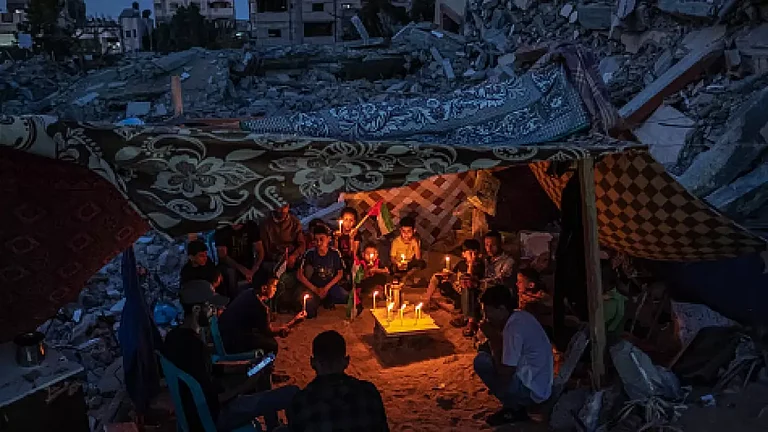The first cases emerged in late November, last year, in Qom, some 125 kilometers (80 miles) southwest of Iran’s capital, Tehran. There, in a heartland of Shiite theologians and pilgrims, students at the Noor Yazdanshahr Conservatory fell ill in November. They then fell ill again in December. Other cases followed, with children complaining about headaches, heart palpitations, feeling lethargic or otherwise unable to move. Some described smelling tangerines, chlorine or cleaning agents.
Since then, for over three months, hundreds of young girls attending different schools in Iran became overpowered by what were believed to be noxious fumes wafting into their classrooms, with some ending up weakened on hospital beds.
Initially, officials in Iran’s theocracy dismissed these incidents, but later described them as intentional attacks involving some 30 schools identified in local media reports, with some speculating they could be aimed at trying to close schools for girls in this country of over 80 million people.
The reported attacks come at a sensitive time for Iran, which already has faced months of protests after the September death of Mahsa Amini following her arrest by the country’s morality police.
Although the authorities did not name the suspects, the attacks raised fears that other girls could be poisoned apparently just for seeking an education — something that’s never been challenged before in the over 40 years since the 1979 Islamic Revolution. Iran itself also has been calling on the Taliban in neighboring Afghanistan to have girls and women return to school.
What happened?
At first, authorities didn’t link the cases as it was winter in Iran, where temperatures often drop below freezing at night. Many schools were heated by natural gas, leading to speculation it could be carbon monoxide poisoning affecting the girls. The country’s education minister initially dismissed the reports as “rumors.”
But the schools affected at first only taught young women, fueling suspicion it wasn’t accidental. At least one case followed in Tehran, with others in Qom and Boroujerd. At least one boys’ school was targeted as well.
Slowly, officials began taking the claims seriously. Iran’s prosecutor-general ordered an investigation, saying “there are possibilities of deliberate criminal acts.” Iran’s Intelligence Ministry reportedly investigated as well.
“After several poisonings of students in Qom schools, it was found that some people wanted all schools, especially girls’ schools, to be closed,” the state media quoted Younes Panahi, a deputy health minister, as saying.
A Health Ministry spokesman, Pedram Pakaieen, said the poisoning didn’t come from a virus or a microbe. Neither elaborated further.
Ali Reza Monadi, a national parliament member who sits on its education committee, described the poisonings as “intentional.”
The ”existence of the devil’s will to prevent girls from education is a serious danger and it is considered very bad news,” he said. “We have to try to find roots” of this.
2014 acid attacks
Attacks on women have happened in the past in Iran, most recently with a wave of acid attacks in 2014 around Isfahan, at the time believed to have been carried out by hard-liners targeting women for how they dressed. But even in the chaos surrounding the Islamic Revolution, no one targeted schoolgirls for attending classes.
Jamileh Kadivar, a prominent former reformist lawmaker and journalist, wrote in Tehran’s Ettelaat newspaper that as many as 400 students have fallen ill in the poisonings.
She warned “subversive opposition” groups could be behind the attacks. However, she also raised the possibility of “domestic extremists” who “aim to replace the Islamic Republic with a caliphate or a Taliban-type Islamic emirate.”
She cited a supposed communique from a group calling itself Fidayeen Velayat that purportedly said, “the study of girls is considered haram” and threatened to “spread the poisoning of girls throughout Iran” if girls’ schools remain open.
Another reformist politician Azar Manoosri tweeted, "If operatives of the acid attacks had been identified and punished then, today a group of reactionaries would not have ganged up on our innocent girls in the schools."
Yoghurt thrown at women for not wearing Hijab
In the first week of April, President Ebrahim Raisi said that the hijab is “a legal matter” in Iran after a viral video appeared to show a man throwing yoghurt at two uncovered women in a shop near a holy Shia Muslim city.
Iranian President Ebrahim Raisi said on Saturday that the hijab was the law in Iran after a viral video showed a man throwing yoghurt at two unveiled women in a shop in a town near the northeastern city of Mashhad.
In live remarks on state television, Raisi said: "If some people say they don't believe (in the hijab)... it's good to use persuasion ... But the important point is that there is a legal requirement ... and the hijab is today a legal matter."
Video footage widely shared on social media in Iran appeared to show the two female customers, who were not wearing the mandatory hijab or headscarf, in a shop being assaulted by a man after a verbal altercation.
The footage shows the man pouring a bucket of what appears to be yogurt on the two women's heads before he is confronted by the shopkeeper.
(with agency inputs)


























